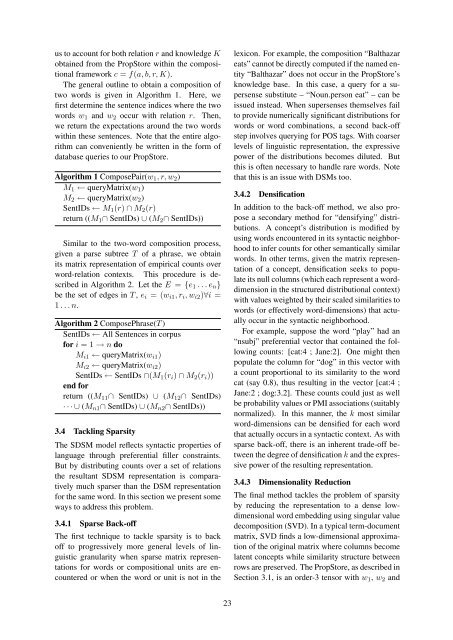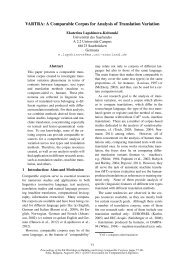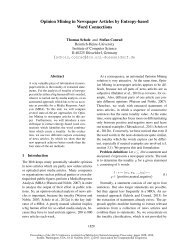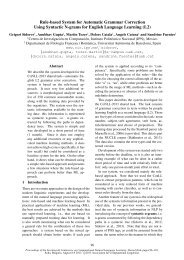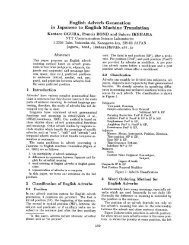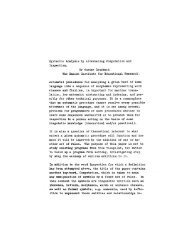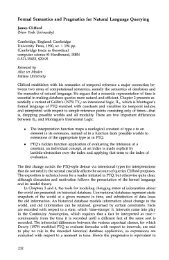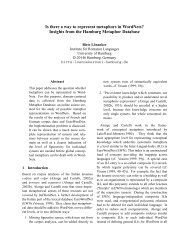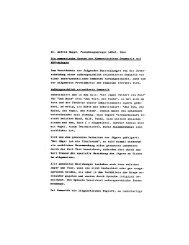Vector Space Semantic Parsing: A Framework for Compositional ...
Vector Space Semantic Parsing: A Framework for Compositional ...
Vector Space Semantic Parsing: A Framework for Compositional ...
You also want an ePaper? Increase the reach of your titles
YUMPU automatically turns print PDFs into web optimized ePapers that Google loves.
us to account <strong>for</strong> both relation r and knowledge K<br />
obtained from the PropStore within the compositional<br />
framework c = f(a, b, r, K).<br />
The general outline to obtain a composition of<br />
two words is given in Algorithm 1. Here, we<br />
first determine the sentence indices where the two<br />
words w 1 and w 2 occur with relation r. Then,<br />
we return the expectations around the two words<br />
within these sentences. Note that the entire algorithm<br />
can conveniently be written in the <strong>for</strong>m of<br />
database queries to our PropStore.<br />
Algorithm 1 ComposePair(w 1 , r, w 2 )<br />
M 1 ← queryMatrix(w 1 )<br />
M 2 ← queryMatrix(w 2 )<br />
SentIDs ← M 1 (r) ∩ M 2 (r)<br />
return ((M 1 ∩ SentIDs) ∪ (M 2 ∩ SentIDs))<br />
Similar to the two-word composition process,<br />
given a parse subtree T of a phrase, we obtain<br />
its matrix representation of empirical counts over<br />
word-relation contexts. This procedure is described<br />
in Algorithm 2. Let the E = {e 1 . . . e n }<br />
be the set of edges in T , e i = (w i1 , r i , w i2 )∀i =<br />
1 . . . n.<br />
Algorithm 2 ComposePhrase(T )<br />
SentIDs ← All Sentences in corpus<br />
<strong>for</strong> i = 1 → n do<br />
M i1 ← queryMatrix(w i1 )<br />
M i2 ← queryMatrix(w i2 )<br />
SentIDs ← SentIDs ∩(M 1 (r i ) ∩ M 2 (r i ))<br />
end <strong>for</strong><br />
return ((M 11 ∩ SentIDs) ∪ (M 12 ∩ SentIDs)<br />
· · · ∪ (M n1 ∩ SentIDs) ∪ (M n2 ∩ SentIDs))<br />
3.4 Tackling Sparsity<br />
The SDSM model reflects syntactic properties of<br />
language through preferential filler constraints.<br />
But by distributing counts over a set of relations<br />
the resultant SDSM representation is comparatively<br />
much sparser than the DSM representation<br />
<strong>for</strong> the same word. In this section we present some<br />
ways to address this problem.<br />
3.4.1 Sparse Back-off<br />
The first technique to tackle sparsity is to back<br />
off to progressively more general levels of linguistic<br />
granularity when sparse matrix representations<br />
<strong>for</strong> words or compositional units are encountered<br />
or when the word or unit is not in the<br />
lexicon. For example, the composition “Balthazar<br />
eats” cannot be directly computed if the named entity<br />
“Balthazar” does not occur in the PropStore’s<br />
knowledge base. In this case, a query <strong>for</strong> a supersense<br />
substitute – “Noun.person eat” – can be<br />
issued instead. When supersenses themselves fail<br />
to provide numerically significant distributions <strong>for</strong><br />
words or word combinations, a second back-off<br />
step involves querying <strong>for</strong> POS tags. With coarser<br />
levels of linguistic representation, the expressive<br />
power of the distributions becomes diluted. But<br />
this is often necessary to handle rare words. Note<br />
that this is an issue with DSMs too.<br />
3.4.2 Densification<br />
In addition to the back-off method, we also propose<br />
a secondary method <strong>for</strong> “densifying” distributions.<br />
A concept’s distribution is modified by<br />
using words encountered in its syntactic neighborhood<br />
to infer counts <strong>for</strong> other semantically similar<br />
words. In other terms, given the matrix representation<br />
of a concept, densification seeks to populate<br />
its null columns (which each represent a worddimension<br />
in the structured distributional context)<br />
with values weighted by their scaled similarities to<br />
words (or effectively word-dimensions) that actually<br />
occur in the syntactic neighborhood.<br />
For example, suppose the word “play” had an<br />
“nsubj” preferential vector that contained the following<br />
counts: [cat:4 ; Jane:2]. One might then<br />
populate the column <strong>for</strong> “dog” in this vector with<br />
a count proportional to its similarity to the word<br />
cat (say 0.8), thus resulting in the vector [cat:4 ;<br />
Jane:2 ; dog:3.2]. These counts could just as well<br />
be probability values or PMI associations (suitably<br />
normalized). In this manner, the k most similar<br />
word-dimensions can be densified <strong>for</strong> each word<br />
that actually occurs in a syntactic context. As with<br />
sparse back-off, there is an inherent trade-off between<br />
the degree of densification k and the expressive<br />
power of the resulting representation.<br />
3.4.3 Dimensionality Reduction<br />
The final method tackles the problem of sparsity<br />
by reducing the representation to a dense lowdimensional<br />
word embedding using singular value<br />
decomposition (SVD). In a typical term-document<br />
matrix, SVD finds a low-dimensional approximation<br />
of the original matrix where columns become<br />
latent concepts while similarity structure between<br />
rows are preserved. The PropStore, as described in<br />
Section 3.1, is an order-3 tensor with w 1 , w 2 and<br />
23


